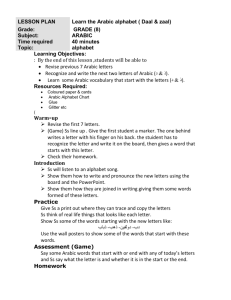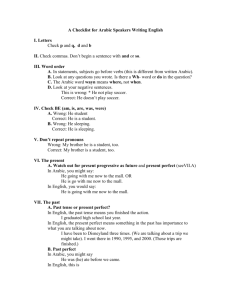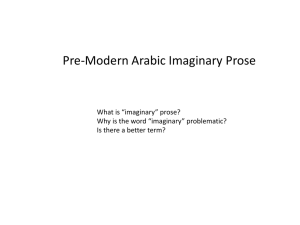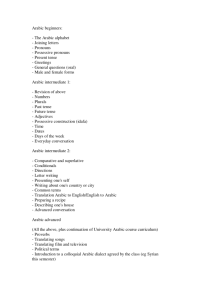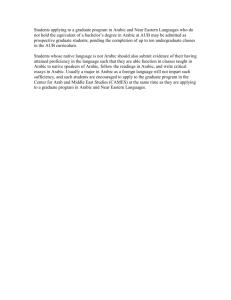Early Modern Prose
advertisement
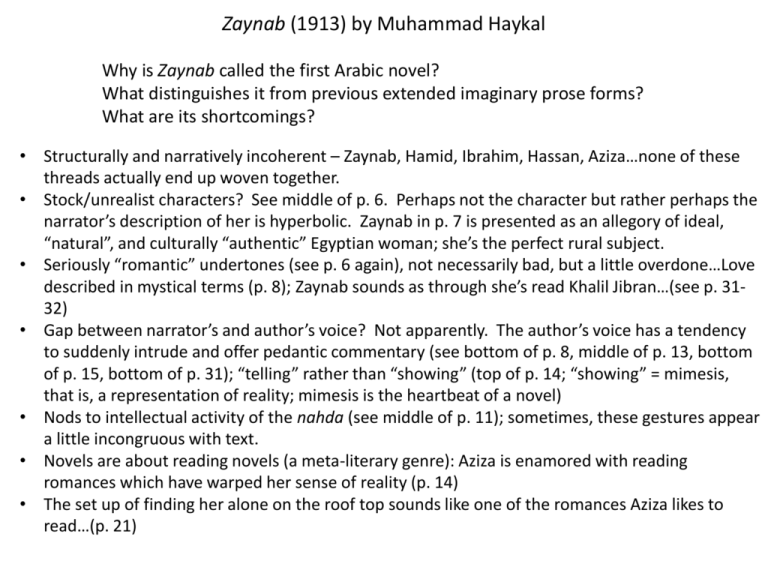
Zaynab (1913) by Muhammad Haykal Why is Zaynab called the first Arabic novel? What distinguishes it from previous extended imaginary prose forms? What are its shortcomings? • Structurally and narratively incoherent – Zaynab, Hamid, Ibrahim, Hassan, Aziza…none of these threads actually end up woven together. • Stock/unrealist characters? See middle of p. 6. Perhaps not the character but rather perhaps the narrator’s description of her is hyperbolic. Zaynab in p. 7 is presented as an allegory of ideal, “natural”, and culturally “authentic” Egyptian woman; she’s the perfect rural subject. • Seriously “romantic” undertones (see p. 6 again), not necessarily bad, but a little overdone…Love described in mystical terms (p. 8); Zaynab sounds as through she’s read Khalil Jibran…(see p. 3132) • Gap between narrator’s and author’s voice? Not apparently. The author’s voice has a tendency to suddenly intrude and offer pedantic commentary (see bottom of p. 8, middle of p. 13, bottom of p. 15, bottom of p. 31); “telling” rather than “showing” (top of p. 14; “showing” = mimesis, that is, a representation of reality; mimesis is the heartbeat of a novel) • Nods to intellectual activity of the nahda (see middle of p. 11); sometimes, these gestures appear a little incongruous with text. • Novels are about reading novels (a meta-literary genre): Aziza is enamored with reading romances which have warped her sense of reality (p. 14) • The set up of finding her alone on the roof top sounds like one of the romances Aziza likes to read…(p. 21) On Zaynab: “[Zaynab] consists of all the classic elements of its European models: long sustained idylls about the Egyptian countryside, episodes of romantic passion, the struggle to adhere to the accepted patterns of social virtue as against following one’s natural, instinctive, inclinations” (Robin Ostle, “The Arabic World” in Modern Literature and the Near East: 1850-1970, p. 105). “[The] long sustained passages of idyllic description of scenes of the Egyptian countryside represent the author’s dream visions about his society. The fellahin, the peasant characters including Zaynab herself, take on almost heroic dimensions. At a time when Haykal and his generation were trying to create new political and social identities for the community, it was natural that they countryside should become a vital ideological necessity for the discourse of politics, and for the imagery of the new literature of national authenticity” (Robin Ostle, “The Arabic World” in Modern Literature and the Near East: 1850-1970, p. 105). Early Modern Prose: The Romantic Era The romance vs. romantic-era literature (and music, art, etc.) Basic tenets: • preoccupation with inner life, gaze inwards -> emotional life more powerful, more significant, more relevant, than social conventions, decorum, or standards • dissatisfaction with logic, reason, and empirical means for understanding reality -> subjective as valid as objective • belief in the cultural authenticity of the peasant and “folk” beliefs; rejection of elite knowledge and epistemologies • Linked with incipient nationalism – a mystical bond between a “folk” and the land • Rejection of bourgeois materialism, embrace of spiritualism (Sturm und Drang) Famous romantic-era poets, novelists, composers, painters in West? End of the romantic-era? Romantic Era in Arabic Literature (late 19th century through the first half of 20th century) • Took root amongst Arab poets living abroad (in the US/NYC and South America): the mahjar (“ex-pat community”) • Khalil Gibran (Jibran), Mikha’il Na’ima (Naimy), Amin al-Rihani (and others): all based in NYC, originally from Lebanon. Gibran and Na’ima formed “The Pen League” in 1920, a collection of Arab writers and intellectuals based in NYC who were dedicated to “[lifting] Arabic literature form the quagmire of stagnation and imitation, and [infusing] a new life into its veins” (Nadeem Naimy, The Lebanese Prophets of New York, p. 18). • Inspired by Western romantic-era poetry and American transcendentalism, Walt Whitman in particular. The literary efforts of The Pen League are credited with moving Arabic literature beyond the neo-classicism of the 19th and early 20th centuries, and thus serving as an intermediate phenomenon between neo-classicism and modern realism. • Dissatisfaction with conventional formal requirements of Arabic poetry (uniform meter, uniform rhyme, uniform line structure); rejection of “sterile” and “moribund” conventions. Thus, initially a poetic phenomenon in Arabic literature. • Imbued with spiritualism and contemplation, “Eastern spiritualism” vs. “Western materialism”; a yearning for spiritual transcendence, often expressed through the metaphoric language of the lover and beloved. Deeply sentimental, dealt with existential matters (often in a heavy-handed manner); unremittingly sincere and earnest • Diction that is “modern, elegant, and original”; “imagery that was evocative and imbued with a healthy measure of emotion” (Jayyusi, p. 5). • Revolutionary in its confrontation of social taboos; not, however, overtly political. • • • • Khalil Jibran/Gibran (1883-1931) “The third best selling poet of all time” after Shakespeare and Lao-tzu (“Prophet Motive”, The New Yorker, 1/7/2008, accessed online 9/30/2015). Wrote The Prophet, an extended prose-poetry oration by a mystic saint from the East who preaches a doctrine of carpe diem, love, peace, contemplation, mindfulness, etc. Essentially, an early work of New Age-y self-help and inspiration. Initially wrote in English before turning to Arabic More famous perhaps in the Occident (primarily the United States) than in the Arab World, although his contributions to Arabic literature have come to be reconsidered of late. From The Prophet “On Giving” You give but little when you give of your possessions. It is when you give of yourself that you truly give. For what are your possessions but things you keep and guard for fear you may need them tomorrow? And tomorrow, what shall tomorrow bring to the overprudent dog burying bones in the trackless sand as he follows the pilgrims to the holy city? And what is fear of need but need itself? Is not dread of thirst when your well is full, the thirst that is unquenchable? The Broken Wings (1912) by Khalil Gibran How does this text not conform with your expectations of a modern novel? • Dialogue has no basis in reality whatsoever (p. 14-15); too overwrought and oratorical to be anything but “born literary”. • Characters (the wicked archbishop and his nephew, daughter of Faris Karama) are stock characters, if not purely allegorical (stifling, parasitic tradition vs. unfettered purity) • “Jibran’s flowery language can be difficult to follow at times, and the repeated use of dramatic simile does feel slightly histrionic to a more modern literary palate. In spite of this, there is an earnest truth to each comparison, image, and observation detailed in the prose. Perhaps therein lies the cultural and stylistic difference between this work and later ones. Most modern novels express some form of irony between the lines, whereas Broken Wings (possibly due to its quasi-autobiographical nature) feels considerably more straightforward” (Becca Brown, Homework #3, 9/30/2015) • “Modern novel writing assumes its self awareness within the narrative; however, we can see across many of these stories that Gibran is only conscious of himself almost as though while writing a poem. He self-indulgently emphasizes the number of metaphors and figures of speech he can integrate within a sentence, while keeping personal sensory and environmental details to a minimum” (Mayed al-Remaihi, Homework #3, 9/30/2015).



